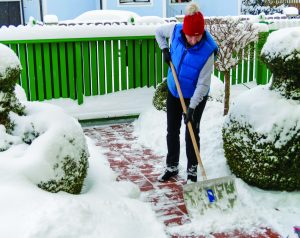Whether you’re dealing with a light dusting or a blizzard, cleaning up snow can be a pain. It’s an everyday chore that’s deceptively dangerous. Every year, more than 100 people die shoveling snow. Even if it doesn’t kill you, 11,500 Americans end up in the hospital each year because of snow shoveling injuries.
The most significant danger of snow shoveling is the strain it puts on your heart, which can trigger a heart attack. Studies have shown that even using a heavy snow blower can be dangerous. The fact is that shoveling snow is very hard work. In shape or not, shoveling is incredibly strenuous and puts you at risk of heart attack.
Beyond fitness, the cold adds to the threat. Cold air can constrict blood vessels and decrease the amount of oxygen in the heart. Combine this with the strain of shoveling and you have a heart attack cocktail. If you’re older or have previous heart issues, you’re even more likely to succumb to heart issues due to snow removal.
Other dangers of snow shoveling
Heart attacks aren’t the only thing to worry about when you’re clearing away snow. A bad injury can put you out of commission for weeks. Hurting your back from incorrect lifting practices and frequent bending over is one of the most common injuries from snow shoveling. Slips are also common, especially for seniors. Slippery in itself, as you move snow, there’s a chance you may expose even more ice hidden underneath. Falls are especially dangerous for seniors, with 22,900 adults dying from falls in 2011. Even non-fatal falls can lead to broken bones or muscle injuries.
Preventing injuries
Despite the dangers, it’s still important to clear snow and ice from around your house in the event you need to evacuate. If you need to clean a path, how can you do it safely?
The first step is to be honest with yourself. Can you handle clearing away the snow? If you’re a senior or have had heart issues in the past, the answer may be no. If you’re not in the right shape to be shoveling snow, recruit a neighbor or family member. Your loved ones may grumble while they work, but they wouldn’t want you to put yourself in danger.
If you’re well enough to take on the elements, there are a few ways to avoid injury or heart attack. Before heading outside, dress warm (waterproof, if possible) and wear winter boots to prevent slips. Stretching and a light warm-up exercise are also wise since both can prevent muscle strains.
When it’s time begin shoveling, don’t just start lifting snow and tossing it aside. There’s a correct way to shovel snow. First, instead of lifting right away, like you’re digging a hole, push the snow. When it comes time to toss the shoveled snow, lift with your legs. Keep a good lifting technique to ensure you don’t hurt your back. If you begin feeling tired, take a break. Don’t push yourself because this added strain can get you into trouble. Also, if you’re able, try shoveling while it’s still snowing and there’s less on the ground.
When it comes to avoiding slipping, one safety tip is to spread ice melt before the storm to prevent ice from forming. Finally, you can try walking like a penguin, which distributes your weight over your planting foot.
With these safety tips and warnings, you can get the job done and get back inside to warm up by the fire!
Source: living.medicareful.com
Need help with snow removal? Check out these programs
The following programs provide snow removal for community residents in these areas:
City of Pittsburgh residents: Snow Angels program, call 311 or (412) 475-2459. To learn more, visit pittsburghpa.gov/snowangels/index.html.
Mt. Lebanon: High school volunteers, call (412) 344-2114; to learn more, visit mtlebanon.org/136/Snow-Removal. For a cost, Little’s Landscaping, LLC will remove snow; call (412)952-6856.
Brentwood: The Department of Administration, call (412) 884-1500; to learn more, visit brentwoodboro.com/snow-removal.html.

